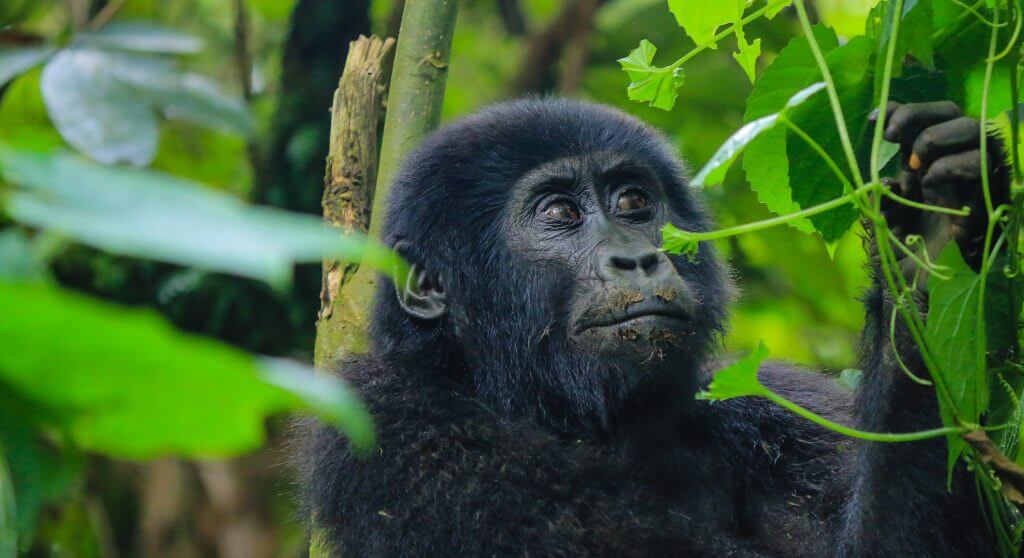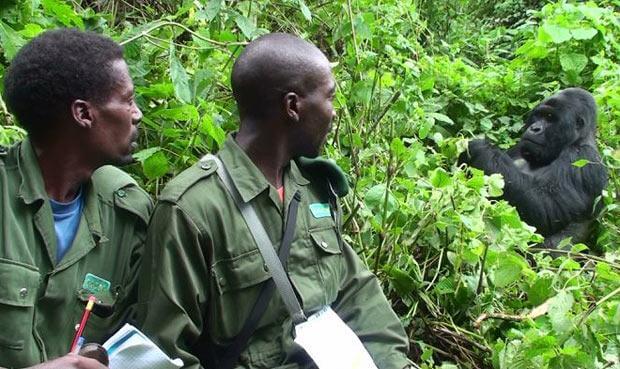Gorilla Trekking Vs Habituation
A Detailed Comparison Between Gorilla Trekking Vs Habituation
Gorilla Trekking Vs Habituation. What is the difference between Gorilla Trekking and Mountain Gorilla Habituation? Choosing between normal trekking and habituation often poses challenges among gorilla trekkers. Not to leave you in the world of puzzles, we have put together a detailed guide providing complete comparison between gorilla trekking Vs habituation. Our guide provides deep insight into each primate adventure (gorilla trekking Vs habituation) to help you when planning your next gorilla safari holiday to Africa.
Gorilla Trekking Vs Habituation
Gorilla trekking is an exhilarating, once-in-a-lifetime experience that introduces visitors to families of endangered mountain gorillas in their natural habitats.
Since the 1980s, when Dian Fossey, through her research on mountain gorillas, alerted the World to the plight of these Giant Apes, interest in them and their conservation has intensified. Gorilla trekking is a crucial element in the long-term protection of these giant apes’ populations, allowing visitors to go on guided treks through the rainforest and spend up to 60 minutes with them in their natural habitats.
However, for gorilla trekking to be possible, Habituation of these Giant Apes should have taken place first. In this guide, we will explore these two interesting activities, including where they are done, the cost of both experiences, the best time to participate, and how to book your gorilla safari.

What is Gorilla Habituation?
Habituation occurs when the endangered mountain gorillas are repeatedly exposed to constant human presence and eventually stop running away when visited. Wild mountain gorillas, like any other wildlife species, should have a fear of humans, but in places where they are tracked (such as DRC’s Virunga National Park, Uganda’s Bwindi Impenetrable and Mgahinga National Park, or Rwanda’s Volcanoes National Park), they are first exposed to people (especially researchers, trackers, Rangers, and guides) through a planned process, for an extended period (2-5 years).
For instance, if a visitor comes close trying to take a picture of mountain gorillas, they will naturally run away or become aggressive (perceiving you as a threat). But with repeated visits and training from the “Habituation team”, they will become less afraid of humans, and visitors will eventually be allowed to come close through “Gorilla trekking tours”.
What does it mean when a gorilla is habituated?
To be considered habituated, the mountain gorilla loses its natural wary behavior, not perceiving humans as threats, through frequent, repeated exposure to people. They will not retreat into the thick vegetation when visited and will go on with their daily routines (playing, foraging, resting, grooming, nursing infants, or mating) while visitors take photos and view them.
After habituation, mountain gorillas will no longer see humans as a threat, and then visitors will be allowed to come close to them (while maintaining the minimum viewing distance of 7 meters). However, in some places, visitors are allowed to see semi-habituated mountain gorillas (those that aren’t fully habituated or still undergoing Habituation) in a process known as the “Gorilla Habituation Experience.”
Is gorilla trekking and habituation safe?
We have had several visitors ask whether gorilla trekking and habituation tours are safe. The short answer is yes, these adventures are both ethical and safe for the Giant Apes and visitors, as long as visitors follow strict rules and regulations established by relevant Authorities and provided during pre-tracking briefing.
First, this is because these Giant Apes are first habituated (whether partially or fully) and considered safe to be visited by travelers. Also, visitors and the tracking team always remain at a safe viewing distance from the mountain gorillas, ensuring the Giant Apes aren’t frustrated.
So, do you know how gorilla trekking is different from the Gorilla Habituation process? Read on for more details.
What is the difference between Gorilla Trekking and the Gorilla Habituation Experience?
Visits to fully habituated vs. semi-habituated mountain gorillas
It is important to note that gorilla trekking involves visiting fully habituated gorilla families, having undergone the process for 2-5 years. This means the Giant Apes are less shy and more accustomed to human presence, hence there is a limited chance of them running into hiding once visited by trekkers or even the Park team (trackers, researchers, and Rangers).
The Gorilla Habituation Experience is done for semi-habituation gorilla families, meaning they are partially habituated (but not entirely unhabituated). This also means that you are visiting slightly shyer mountain gorillas, and might not get as close to them as you could on standard gorilla trekking tours. You will also notice some, especially infants, remain hidden and run away during viewing and photography.
You might not successfully get close to the Giant Apes during the Gorilla Habituation Experience, as you would during Gorilla trekking tours. Considering visitors are introduced to shyer individuals, this experience provides a more authentic encounter with the Giant Apes, although it requires more patience and a lot of moving around to capture perfect moments of them on camera.
Time spent with the Mountain gorillas: one hour vs. four hours
As gorilla trekking involves visiting fully habituated mountain gorillas, visitors are allowed to spend only one hour with them (taking photos and learning about their human-like behavior), visitors will spend up to four hours with the Giant Apes during the Habituation experience.
While both adventures usually involve trekking for several hours and require a reasonable level of physical fitness, this is quite different with the Habituation Experience, as it involves taking the less-explored tracks. The Trail is often more muddy and slippery, and once sighted, you have four hours with the Giant Apes.
The main reason why you need more time with the mountain gorillas is that they are partially habituated, hence shyer, and will give a harder time to photograph. Visitors have more time to watch the mountain gorillas go about their daily routines and take as many photos as possible.
Number of participants: 8 visitors vs. 4 visitors
Both gorilla trekking and the Gorilla Habituation Experience are done with a limited number of visitors, primarily to protect the Giant Apes from stress and disturbances, hence ensuring a sustainable and enjoyable viewing experience for all visitors. Limiting the number of visitors is an easier way to minimize the impact of gorilla trekking tours on mountain gorilla behavior and overall well-being.
However, the number is further reduced to four visitors per gorilla family during the Gorilla Habituation Experience. This is attributed to the fact that these Giant Apes are rawer, still timid, and to ensure a more authentic viewing experience.
Where the activities are done
Visitors can undertake gorilla trekking tours in any of the four National Parks sheltering these Giant Apes- Virunga National Park in the Democratic Republic of Congo, Rwanda’s Volcanoes National Park, and Bwindi Impenetrable National Park and Mgahinga Gorilla National Park in southwestern Uganda. This isn’t the case with the Gorilla Habituation Experience, which is only offered in one destination, Bwindi Impenetrable National Park.
It will interest you to know that Bwindi Impenetrable National Park is divided into four trekking sectors/regions- Rushaga and Nkuringo to the south, Buhoma in the North, and Ruhija in the East. All these sectors can be visited for standard gorilla treks, while only the Rushaga sector provides the Habituation Experience.
Cost of the Adventures -Gorilla Trekking Vs Habituation
Gorilla trekking permit prices depend on your choice of destination, costing $400 per person in the Democratic Republic of Congo, $800 per person for tracking in any of Uganda’s two trekking National Parks, and $1500 per person for gorilla trekking in Rwanda.
A Gorilla Habituation permit will cost you only $1500 per person, and will guarantee four hours of viewing and photographing the Giant Apes in their natural habitats. This cost doesn’t include the cost of hiring a porter ($15 to $20), which isn’t mandatory but recommended to assist in carrying your backpack and holding your hands as you hike to areas of higher elevations or slopes.
Best time to go for gorilla trekking Vs Habituation Experience
Gorilla trekking and Habituation Experience tours are available all year round. However, each season comes with different challenges and advantages.
For instance, if you choose the dry months- January, February, June, July, August, and September and December for these life-changing activities, then be prepared for longer treks. This is because these Great Apes move deeper and farther into the forests to search for food. On the good side, rainfall levels are reduced, hence drier trails and less challenging treks.
The dry season coincides with the peak gorilla season, hence availability for gorilla permits and accommodations is quite tricky. However, you can overcome this by booking your adventure at least 6 months to one year in advance.
Gorilla trekking and the Habituation Experience adventures in the wet season (March to May and October to November) are quite challenging as gorilla trekking trails become difficult-to-navigate due to increased rainfall and denser vegetation. The advantages of this season include shorter gorilla treks as mountain gorillas move close to forest boundaries, as they have plenty of food.
Also, the wet season coincides with the low season, thus the availability of gorilla permits and accommodation isn’t an issue, even for last-minute bookings. While last-minute bookings are possible, it is always recommended to book your gorilla tour at least 3-4 months in advance.
Also, the low season could be a perfect idea to save on your gorilla tour, as several safari Lodges provide low-season discounts. Please contact us for advice on some of these accommodations.


